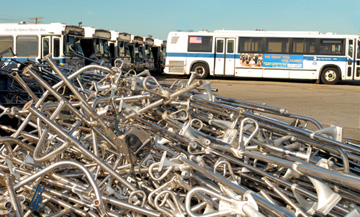Older bus parts salvaged for vehicles with more miles to run
By Charles F. Seaton

MTA New York City Transit has consigned its older transit buses as organ donors to prolong the lives of other buses. As MTA Bus currently takes delivery of the first of 850 Orion Vll Hybrid-Electric buses, a similar number of older Orion and RTS buses hit the dust. MTA Bus is moving hundreds of retired vehicles to a central facility, stripping them of serviceable parts and draining off fluids for re-use in similar models with many more miles to run.
In the past the retired buses would have sold to the highest bidder for its scrap value with only an occasional part removed. As a rule, the buses taken from service turned up with scores of valuable components still good for many more miles and years of use.
With 12- to 18-year life cycles, New York City buses typically travel nearly a half-million miles over rough streets transporting passenger loads stretched to capacity. Formerly when the agency removed a fleet of buses from service, it sold off the entire bus with the buyer driving to each depot to tow away the hulks.
“That has been industry practice for as long as there have been buses,” says Joseph Smith, president of MTA Bus and Long Island Bus, and senior vice president, NYC Transit Department of Buses. “We figured there was a better way that would benefit both the MTA and the environment.”
MTA NYC began this new initiative in late summer 2008 and has fine-tuned the process ever since. Today, scores of stripped buses from the 28 depots sit in neat rows at the MTA Bus Company Eastchester Depot in the north Bronx, where the recycling takes place.
“This program is relatively new but has already saved us more than $600,000,” says Smith. “Aside from saving money, we are using and reusing our resources wisely. Fuel, engine oil, Freon — those are substances that have both a financial and an environmental value.”
Technicians refer to a checklist to keep track of the 80-some retainable components on the buses. Items too badly worn to be of use remain with the bus. The list does not contain such consumables as hoses or air bags.
Special deconstruction teams pull the buses into bays two at a time and take them apart, drain fluids from the tanks, and remove and sort anything of value from engines and transmissions to rear-view mirrors. It takes approximately 30 hours to strip a bus of everything that is suitable for re-use on another vehicle.
“When they get finished with a bus, it looks like a turkey carcass after Thanksgiving,” says Smith. There isn’t a lot of it left.”
Since August the teams have dispatched 18 tractor trailers filled with parts to depots around the system. Additionally, they have reclaimed and recycled some 8,000 gallons of diesel and 400 pounds of Freon, while hand holds, passenger seats and undamaged windows are made ready for their next call to duty.
Smith says the job of recycling buses is more art than science, in which workers who previously toiled at putting buses together now excel at taking them apart.
Charles F. Seaton is with the MTA New York City Transit Office of Public Affair
